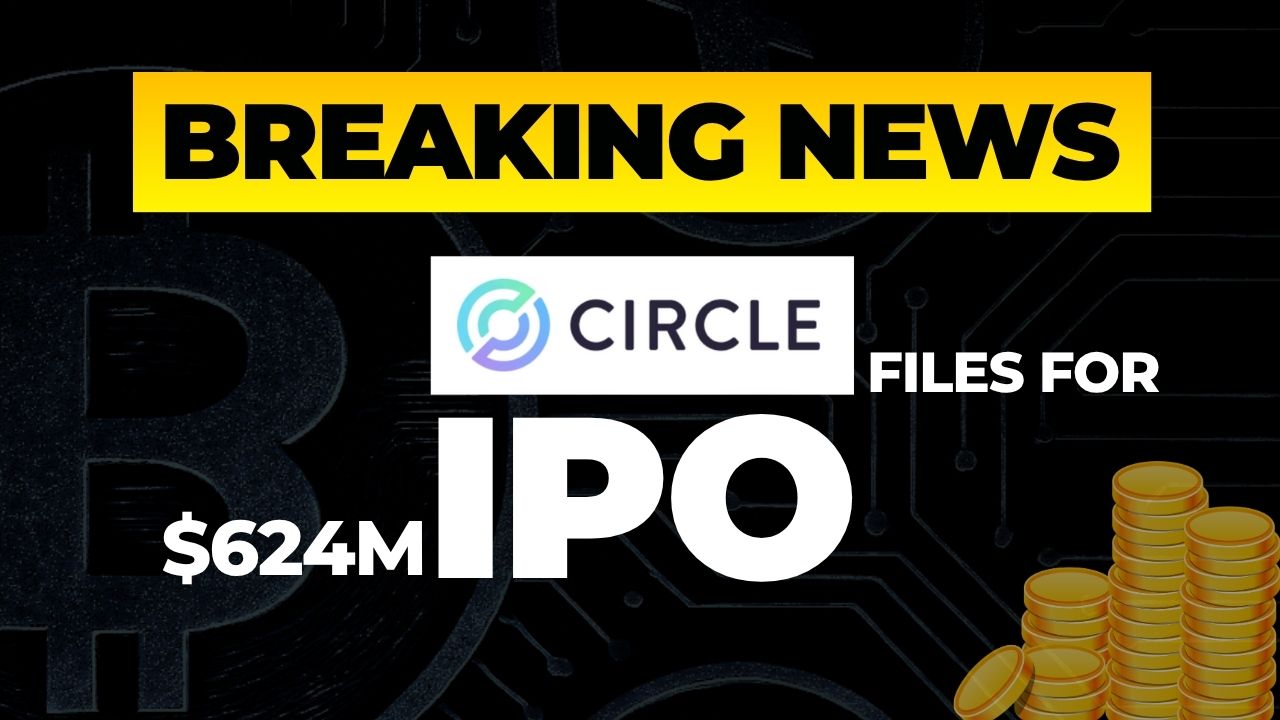Circle Internet Group — the company behind that USDC “digital dollar” you keep hearing about — just filed to go public on the NYSE.
But here’s what every headline got wrong: This isn’t just another crypto company trying to cash in. This is the moment stablecoins officially became Wall Street infrastructure.
Company Overview
Circle runs USDC — basically a digital version of the U.S. dollar that businesses use to move money around instantly. No waiting days for bank transfers. No ridiculous international wire fees. Just boom, money moves.
| Company Name | Circle Internet Group |
| Founded | 2013 |
| Headquarters | New York, USA |
| CEO | Jeremy Allaire |
| Core Product | USDC (USD Coin), a stablecoin pegged 1:1 to the U.S. dollar |
| Industry | Fintech, Cryptocurrency, Stablecoin Infrastructure |
| Market Position | Second-largest stablecoin issuer by market capitalization |
| Key Investors | Goldman Sachs, BlackRock, Fidelity |
| Previous IPO Attempt | Failed SPAC deal in 2022; Circle Internet Group IPO is second attempt |
The numbers are wild: USDC processes over $7 trillion in transactions every year. That’s not speculation money — that’s real businesses paying real bills with digital dollars.
And get this — Goldman Sachs and BlackRock aren’t just throwing money at Circle for fun. They actually use USDC infrastructure for their own operations. When Wall Street’s biggest players become your customers, you know you’re onto something real.
The CRCL IPO Breakdown
Circle Internet Financial officially filed for its IPO on May 27, 2025, and the stock is set to begin trading on the New York Stock Exchange (NYSE) on June 5, 2025, under the ticker CRCL.
Here’s what you need to know about the IPO:
- Total Shares Offered: 24 million Class A shares
- Price Range: $24 to $26 per share
- Valuation Target: Between $5.2 billion to $6.71 billion
Who’s Selling the Shares?
- Circle Itself is offering 9.6 million shares
- Existing Shareholders like Accel, General Catalyst, and co-founders Jeremy Allaire and Sean Neville are selling 14.4 million shares
Underwriters:
Big investment banks are backing this IPO, including:
- J.P. Morgan
- Citigroup
- Goldman Sachs
They also have the option to buy 3.6 million more shares if demand stays strong.
Big Investors Are Interested:
- Cathie Wood’s ARK Invest is planning to invest up to $150 million in Circle’s shares.
- According to Bloomberg, the IPO is already multiple times oversubscribed. That means way more people want to buy shares than the number of shares available — a sign that there is strong demand for Circle’s stock.
Everyone’s talking about Circle raising $624 million by selling shares at $24-26 each. That’s the surface story.
Here’s what actually matters: Circle made $1.68 billion in revenue last year. Not from people gambling on crypto prices, but from businesses using their payment infrastructure. That’s PayPal-level money, but with way better growth.
Their profit dropped to $157 million because they’re spending heavily on expansion. Smart companies do this before going public — invest everything in growth, then let public markets fund the next phase.
The share split is interesting too. Circle’s selling 9.6 million new shares, but existing investors are cashing out 14.4 million shares. That’s not desperation — that’s confidence. Early investors are taking profits because they know the public market will value Circle higher than private investors did.
Also Read – Circle IPO Price Prediction – What’s Next for CRCL’s $624M Debut?
The CRCL IPO has launched at a time when the GENIUS Act is making its way through the U.S. Senate. This bill was moved forward with a 66-32 procedural vote on May 19, 2025, gaining support from 16 Democrats, including Senators Cory Booker and Adam Schiff. Just a day later, on May 20, the Senate voted 69-31 to start working on amendments to the bill, aiming to pass it by Memorial Day on May 26, 2025.
The full name of the bill is the Guiding and Establishing National Innovation for U.S. Stablecoins Act. It requires stablecoins to be backed 1:1 by liquid assets like cash or U.S. Treasury bonds. It also ensures that stablecoin holders get priority during bankruptcy situations and that strong anti-money laundering rules are followed.
Under the Act, both banks and approved nonbank institutions can issue stablecoins, either under federal or state supervision. Big issuers handling more than $10 billion in stablecoins will come under the watch of the Federal Reserve and the Office of the Comptroller of the Currency (OCC). According to J.P. Morgan, this law could expand the stablecoin market to somewhere between $500 billion and $750 billion, helping boost the growth of USDC. Still, not everyone is on board.
Critics like Senators Elizabeth Warren and Chuck Schumer argue that the bill is tilted in favor of banks and doesn’t provide strong enough protections, such as FDIC insurance. Some of the proposed amendments are aimed at fixing potential conflicts of interest, especially concerns linked to former President Trump’s connections with World Liberty Financial’s USD1 stablecoin.
Also Read – USDC vs. RLUSD vs. USDT – Key Differences and Why They Matter
Why This IPO Actually Matters?
Three things make this different from every other crypto company that tried going public:
First, the timing is perfect. Remember when Coinbase went public in 2021 during peak crypto mania? That was speculation money chasing speculation companies. Circle’s going public now, when institutions actually need digital payment infrastructure. Totally different game.
Second, Circle makes money when businesses use digital payments. They don’t need Bitcoin to hit $100k or people to start day-trading again. Every time someone sends USDC for a real business transaction, Circle gets paid. It’s like owning the toll booth on a highway that gets busier every year.
Third, they’re basically bulletproof on regulations. While other crypto companies are fighting with regulators, Circle spent years building compliance systems. They publish detailed reports about their reserves. They work with U.S. regulators instead of against them. When crypto regulations finally get written, Circle will be the template everyone else has to follow.
The Competition Angle Everyone’s Missing
USDC currently handles about 35% of the stablecoin market.
Tether’s USDT dominates with 65%, but there’s a catch: Tether operates in regulatory gray areas and faces constant questions about whether they actually have the dollars they claim to have.
Also Read – 7 Surprising Facts You Must Know About Tether (USDT) in 2025
Circle’s different. They publish quarterly reports proving every USDC is backed by actual dollars in actual banks. Once they’re a public company, that transparency becomes legally required.
Here’s the kicker: Most big businesses won’t work with companies that might get shut down by regulators. They need reliable partners. Circle’s IPO basically puts a “safe to use” stamp on USDC that Tether can’t match.
What Happens Next Actually Matters for Everyone
If Circle’s IPO goes well, it opens the door for other real crypto infrastructure companies to go public. Not the speculation stuff — the companies building actual useful services.
Think about it: Stripe revolutionized online payments and became worth $95 billion. Circle could do the same thing for international payments and digital money infrastructure.
But if Circle struggles as a public company, it sends a message that even the most legitimate crypto companies aren’t ready for public markets. That delays the whole industry’s growth by years.
Why Regular Investors Should Care
Circle’s stock gives you a way to invest in crypto infrastructure without buying cryptocurrency. You’re betting on digital payments growing, not on Bitcoin’s price going up.
It’s like investing in Visa during the early days of credit cards. You’re not betting on any specific transaction — you’re betting that more transactions will happen electronically over time.
The international angle is huge too. Every country is exploring digital versions of their currency. Circle’s already built the infrastructure for digital dollars. When other countries need similar systems, Circle’s the obvious choice.
The Real Story Nobody’s Telling
This IPO proves something important: The useful parts of crypto are becoming normal business infrastructure. Circle’s not going public as a “crypto company” — they’re going public as a payment infrastructure company that happens to use blockchain technology.
That’s the real shift. Crypto is evolving from speculation to utility. The companies building useful services are separating from the companies chasing hype.
Circle’s IPO is like the moment when Amazon stopped being “that internet bookstore” and became “that logistics company that happens to sell books online.” Same technology, completely different business reality.
What This Means for Your Money
Whether you buy CRCL stock or not, understand what this IPO represents: Digital payments are becoming as normal as email. The companies building that infrastructure early are positioning themselves for massive growth.
Circle’s bet is simple: More business will happen digitally, and that business needs reliable infrastructure. If they’re right, owning that infrastructure becomes incredibly valuable.
The interesting part? You don’t need to understand blockchain technology to understand Circle’s business model. They make money when people use digital dollars for real purposes. That’s as straightforward as business gets.
Also Read – Why I Think America’s Debt Crisis is Driving People into Crypto in 2025?
The Bottom Line
Circle’s IPO isn’t just another crypto company going public. It’s infrastructure becoming a public utility.
The companies that win in crypto aren’t the ones chasing speculation — they’re the ones building services that make digital money actually useful. Circle figured that out years ago, and now they’re cashing in.
Watch how CRCL performs after going public. If it does well, expect more infrastructure-focused crypto companies to follow. If it struggles, the whole sector takes a step back.
The information provided in this article is for informational and educational purposes only and does not constitute financial, investment, or legal advice. Investing in initial public offerings (IPOs) involves significant risks, including the potential loss of principal. The cryptocurrency and stablecoin markets are highly volatile and subject to regulatory changes, which may impact investment outcomes. Readers should conduct their own research and consult with a qualified financial advisor before making investment decisions. The author and publisher are not responsible for any financial losses or damages resulting from the use of this information.
Dawson Blake is a financial markets expert with over 10 years of experience, focusing mainly on stock market news and price movements. He aims to become a top-tier authority in curating stock news content that readers can trust as their go-to source for market information. Dawson enjoys breaking down market activity, company updates, and daily trends to help investors stay informed and make smarter financial decisions. His writing is simple, clear, and designed to make the stock market easy to follow for everyone.

